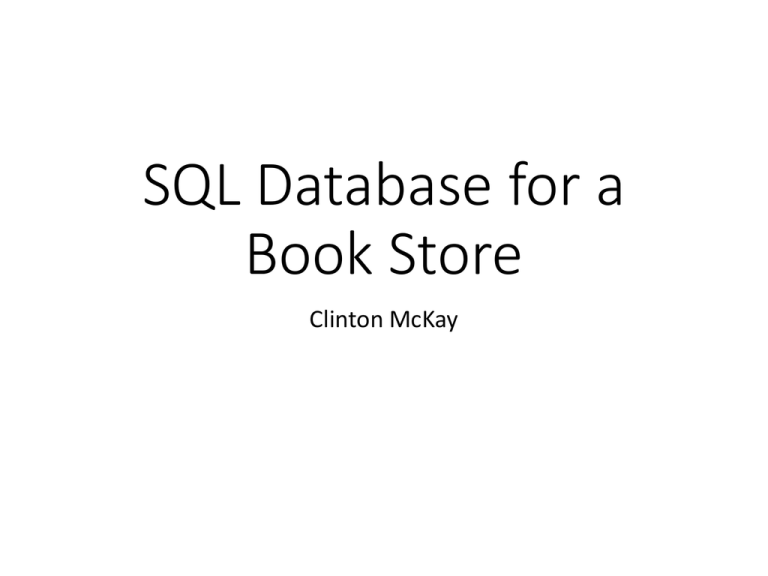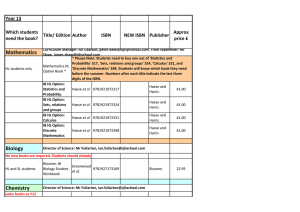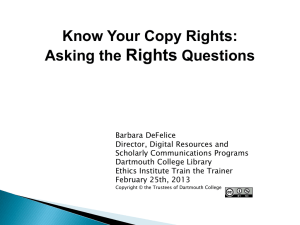PPT - Clinton McKay
advertisement

SQL Database for a Book Store Clinton McKay Explanation The database contains information about the books held in stock, their authors, publishers, customers, sales. The database was populated with information from bibliographic records in IUCat (with some modifications) and do not necessarily represent actual publications. The SQL queries I designed are meant to gather different kinds of useful information about the business. Entity Relationship Diagram Data Dictionary Query 1 List all titles in “book” and include ISBN, author name (as combined from author.fname and author.lname) and the publisher name. SELECT book.title AS "Title", book.isbn AS "ISBN", CONCAT(author.fname, ' ', author.lname) AS "Author", publisher.name AS "Publisher" FROM book, author, publisher WHERE author.author_id=book.author_id AND publisher.publisher_id=book.publis her_id; Query 2 List all customers who have purchased books published since 2007. SELECT customer.fname, customer.lname, book.title, book.publication_date FROM customer JOIN sale ON customer.customer_id=sale.cust_i d JOIN book ON sale.isbn=book.isbn JOIN author ON author.author_id=book.author_id WHERE book.publication_date >= 2007; Query 3 List customers (as combined from customer.fname and customer.lname) who have purchased books published in the UK or the US, as well as the title of the book they purchased and the name of its publisher and order by last name of customer. SELECT CONCAT(customer.fname, ' ', customer.lname), book.title, publisher.country, publisher.name FROM customer JOIN sale ON customer.customer_id = sale.cust_id JOIN book ON sale.isbn = book.isbn JOIN publisher ON book.publisher_id = publisher.publisher_id WHERE publisher.country ='UK' or publisher.country ='US' ORDER BY customer.lname; Query 4 List the number of books sold that have been written by each author and group by author’s first name, then last name. SELECT COUNT(sale.isbn) AS "Number of books sold", CONCAT(author.fname, ' ', author.lname) AS "Author" FROM sale JOIN book ON sale.isbn = book.isbn RIGHT JOIN author ON book.author_id=author.author_id GROUP BY author.fname, author.lname; Query 5 List the different (distinct) genres and how many books belong to each genre, order alphabetically by genre. SELECT distinct book.genre, COUNT(book.genre) FROM book GROUP BY book.genre ORDER BY book.genre ASC; Query 6 List the names and phone numbers of all distinct customers who have ordered books published by US or UK publishers, sort them alphabetically. SELECT DISTINCT (CONCAT (customer.fname, ' ', customer.lname)) AS "Customer Name", customer.phone AS "Customer Phone Number" FROM customer JOIN sale ON sale.cust_id = customer.customer_id JOIN book ON book.isbn = sale.isbn WHERE (CONCAT (customer.fname, ' ', customer.lname)) IN (SELECT CONCAT(customer.fname, ' ', customer.lname) FROM customer JOIN sale ON customer.customer_id = sale.cust_id JOIN book ON sale.isbn = book.isbn JOIN publisher ON book.publisher_id = publisher.publisher_id WHERE publisher.country ='UK' or publisher.country ='US') ORDER BY CONCAT(customer.fname, ' ', customer.lname); Query 7 List customers’ first and last names ordered by the number of books they have purchased, ordered by the number of books purchased. SELECT COUNT(sale.cust_id) AS "Number of Books Purchased", CONCAT (customer.fname, ' ', customer.lname) AS "Customer Name" FROM sale JOIN customer ON customer.customer_id = sale.cust_id GROUP BY customer.fname, customer.lname ORDER BY (COUNT(sale.cust_id)) DESC; Query 8 List the number of records in each table (book, author, sale, customer, and publisher). SELECT DISTINCT (SELECT COUNT(*) FROM book) AS "Books", (SELECT COUNT(*) FROM author) AS "Authors", (SELECT COUNT(*) FROM sale) AS "Sales", (SELECT COUNT(*) FROM customer) AS "Customers", (SELECT COUNT(*) FROM publisher) AS "Publishers" FROM book JOIN author ON author.author_id = book.author_id JOIN sale ON sale.isbn = book.isbn JOIN customer ON customer.customer_id=sale.cust_id JOIN publisher ON publisher.publisher_id = book.publisher_id; Query 9 Create and display a view of all sales with customer name, title of book, author last name, isbn of book, and publisher name. CREATE VIEW listsales AS SELECT CONCAT(customer.fname, ' ', customer.lname) AS "Customer Name", book.title AS "Book", author.lname AS "Author Last Name", book.isbn AS "ISBN", publisher.name AS "Publisher" FROM customer JOIN sale ON customer.customer_id = sale.cust_id JOIN book ON sale.isbn = book.isbn JOIN author ON author.author_id = book.author_id JOIN publisher ON book.publisher_id = publisher.publisher_id ORDER BY customer.lname; SELECT * FROM listsales; Query 10 Books are organized by ISBN—Books with ISBNs greater than 700000000 are housed on the third floor, those with ISBNs between 3000000000 and 700000000 are housed on the second floor, and all others are on the first floor. List all books with their locations. SELECT book.title AS "Title", CASE WHEN book.isbn >= 700000000 THEN 'Located on Third Floor' WHEN book.isbn <= 300000000 THEN 'Located on First Floor' ELSE 'Located on Second Floor' END AS "Location" FROM book;





